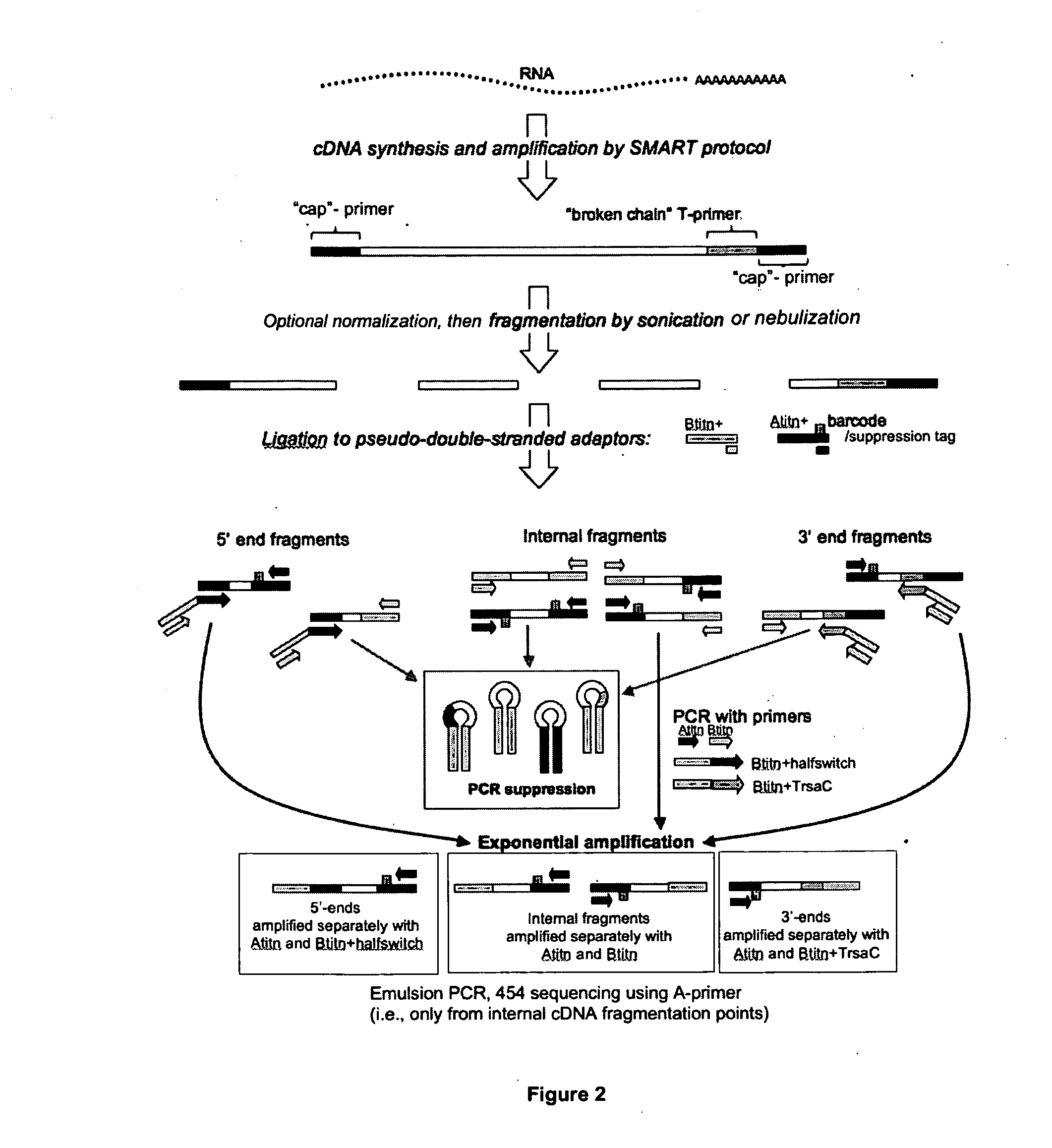Methods and compositions for nucleic acid sequencing
a technology of nucleic acid and composition, applied in the field can solve the problems of not providing even coverage of the length, prior methods suffer from artifacts, and none of the above methods are adapted for high-throughput massively parallel sequencing, so as to improve the quality of nucleic acid sequencing, reduce the fraction of unusable sequences, and eliminate artifacts
- Summary
- Abstract
- Description
- Claims
- Application Information
AI Technical Summary
Benefits of technology
Problems solved by technology
Method used
Image
Examples
example 1
[0025]In one embodiment, the present invention describes method to prepare cDNA samples for sequencing, for example, a 454 Sequencing™ known by the skilled artisan. A 454 Sequencing™ is a parallel pyrosequencing system capable of sequencing about 100 megabases of raw DNA per run. The system relies on fixing nebulized and adapter-ligated DNA fragments to small DNA-capture beads in a water-in-oil emulsion. The DNA fixed to these beads is then amplified by polymerase chain reactions (PCR). Finally, each DNA-bound bead is placed into a approximately 44 μm well on a PicoTiterPlate fiber optic chip for sequencing.
[0026]In the 454 Sequencing™ protocol, four nucleotides are typically washed in series over the PicoTiterPlate. During the nucleotide flow, each of the beads with millions of copies of DNA is sequenced in parallel. If a nucleotide complementary to the template strand is flowed into a well, the polymerase extends the existing DNA strand by adding nucleotides. Addition of one or mo...
example 2
[0047]Preparation of cDNA samples for de novo transcriptome sequencing with 454 technology. The preparation of appropriately modified cDNA is a critical step ensuring the overall success of transcriptome diversity characterization using next-generation sequencing methods. Example 2 is method that has been adapted for the use with 454 technology, with the primary focus on protein-coding transcriptome data assembly and annotation de novo (i.e., in the absence of the reference genome data). This method generates pools of fragmented cDNAs flanked by two standard 454 amplification / sequencing primers, ready for amplification of individual sequences on microbeads and sequencing. The method requires as little as 50 ng total RNA at the start, and solves three most important problems inherent in comparable protocols: artifacts due to long A / T homopolymer regions, large proportion of unusable (adaptor) sequences in the 454 output, and coverage bias towards 3′-termini of transcripts.
[0048]The d...
PUM
| Property | Measurement | Unit |
|---|---|---|
| molar ratio | aaaaa | aaaaa |
| molar ratio | aaaaa | aaaaa |
| molar ratios | aaaaa | aaaaa |
Abstract
Description
Claims
Application Information
 Login to View More
Login to View More - R&D
- Intellectual Property
- Life Sciences
- Materials
- Tech Scout
- Unparalleled Data Quality
- Higher Quality Content
- 60% Fewer Hallucinations
Browse by: Latest US Patents, China's latest patents, Technical Efficacy Thesaurus, Application Domain, Technology Topic, Popular Technical Reports.
© 2025 PatSnap. All rights reserved.Legal|Privacy policy|Modern Slavery Act Transparency Statement|Sitemap|About US| Contact US: help@patsnap.com


